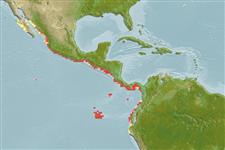Common names from other countries
Classification / Names / Names
Namen | Synonyme | Catalog of Fishes (gen., sp.) | ITIS | CoL | WoRMS
Environment: milieu / climate zone / depth range / distribution range
Ökologie
; tiefenbereich 0 - 40 m (Ref. 4). Tropical, preferred 27°C (Ref. 107945); 28°N - 6°S, 115°W - 77°W (Ref. 112659)
Eastern Pacific: From Baja California Sur to the west coast of Peru and the Galapagos Islands.
Length at first maturity / Size / Gewicht / Alter
Maturity: Lm ?, range 4 - ? cm Max length : 32.0 cm TL Männchen/unbestimmt; (Ref. 4); 30 cm TL (female)
It has lengths of 32 cm (male) and 30 cm (female), maximum total body length; 1 to 13 cm (male) and 1 to 12 cm (female), carapace length (Ref. 4). Maximum depth from Ref. 112672. Occurs at depths from 0 to 18 m and it inhabits shallow coastal waters among rocks and in cracks and crevices. The animals are nocturnal (Ref. 4). Feeds mainly on mollusks, crustaceans and organic matter (Ref. 112086).
Life cycle and mating behavior
Geschlechtsreife | Fortpflanzung | Ablaichen | Eier | Fecundity | Larven
Members of the order Decapoda are mostly gonochoric. Mating behavior: Precopulatory courtship ritual is common (through olfactory and tactile cues); usually indirect sperm transfer.
Holthuis, L.B. 1991. (Ref. 4)
IUCN Rote Liste Status (Ref. 130435)
CITES Status (Ref. 108899)
Not Evaluated
Not Evaluated
Nutzung durch Menschen
Fischereien: kommerziell
FAO - Fischereien: landings | FIRMS (Stock assessments) | FishSource | Sea Around Us
Tools
Internet Quellen
Estimates based on models
Preferred temperature
(Ref.
115969): 22.7 - 29.1, mean 27 (based on 170 cells).
Widerstandsfähigkeit
hoch, Verdopplung der Population dauert weniger als 15 Monate. (K=0.38-0.45).
Verwundbarkeit
Low vulnerability (22 of 100).
